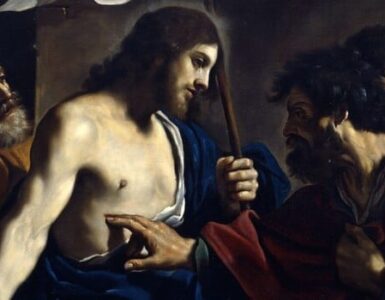“There was a time when I said: ‘Next year I will finally have it together,’ or ‘When I grow more mature these moments of inner darkness will go,’ or ‘Age will diminish my emotional needs.’ But now I know that my sorrows are mine and will not leave me. In fact I know they are very old and very deep sorrows and that no amount of positive thinking or optimism will make them less.”
– Henri Nouwen, Can You Drink the Cup? ( p. 37)
After our second daughter, Sarah, was born with a rare disease, I began feeling discomfort and anger when I would hear common phrases that made perfect sense in the past: “Everything happens for a reason” or “Remember to look at the positive” or “God is in control, just trust Him.” These clichés didn’t work for me anymore. In fact, they drove me further into a pit of loneliness.
Over time, I’ve come to understand the undercurrent of perpetual optimism at the heart of Christianity incarnate. All too often, non-Catholics and Catholics alike toss worn and weary platitudes they have heard or received, because they believe (falsely) that any time a Christian feels crushed by the weight of his/her cross, it is indicative that the Faith will be viewed in a negative light by others.
One such conversation happened to me in the early months following Sarah’s birth. A friend warned me, “Remember, no one will want to be a Christian if all they see is our sorrow and not our joy.” The reality is that Christianity is full of paradoxes. Rather than being downcast or uplifted, we can be both at the same time. The human experience is most fully lived when a person incorporates all of the highs and lows that happen along the way.
What is the “Happy Catholic Narrative”
In recent years, both mainstream and Christian media pump out the happiness message in books, shows, podcasts, and memes. While we are bombarded with the idea that “life will get better, just keep your chin up,” many of us have discovered that we fall flat in our spiritual development by trying to live by these half-truths served on a platter of encouragement.
Editor David Mills calls this “the happy Catholic narrative.” Based loosely on prosperity theology, he explains it as “the mainstream of popular Catholic writing, which was either polemical and culture-warring or happy-happy, presenting Catholic life (teaching and practice) as if it always worked out perfectly. The happy Catholic narrative was normative. People might make a verbal gesture to the limits and problems but it was only a verbal gesture.”
As a result, Mills noticed a lot of faithful Catholics hide their pain, because their experience didn’t fit in with the happiness culture or sunny spirituality offered to them with little else, including authentic accompaniment, in that suffering.
Henri Nouwen wrote in his book, Can You Drink the Cup?, that healing only occurs when we share our pain openly and without shame to others. By naming and giving voice to our brokenness and suffering, we realize we are not as alone as we previously believed. Others, too, carry similar fears and worries to our own.
Christianity Incarnate or Christianity Crucified?
There comes a pivotal time in every dedicated Christian’s life in which s/he must confront the greatest paradox of all: Do I want Christianity incarnate or Christianity crucified?
To clarify, Henri de Lubac described Christianity incarnate not as Jesus Himself, but as the ideals of Christianity we tend to personify in place of who Jesus is. He wrote in his book, Paradoxes of Faith, “What a beautiful plan for Christianity incarnate Satan presented to Jesus in the desert! Jesus preferred a Christianity crucified.” In other words, we make Christianity into an idol of sorts when we only present its happy, sunny face to the world and to ourselves.
Christianity crucified is the ugly part of the paradox of faith. Even Catholics do not want to acknowledge that truly hard, terribly desolate, periods of life come upon us all—“the rain falls upon the just and unjust alike” (see Matthew 5:45). Henri Nouwen further explains this particular paradox in this way: “We fulfill life by emptying it.”
No Christian who trods the path that inevitably leads to their personal Calvary will discover more sunshine and less darkness; in fact, the opposite is true for a time. It’s not so much that we stumble upon true fulfillment in this life. Our hope is not happiness while we are pilgrims on earth. Instead, the hope we hold is in the truth that the resurrection happened for both Jesus, and we can participate in that life after death, too.
We cannot eschew the crucifixion of our egos, our vices, our wayward desires. In fact, Jesus made it clear that these must be annihilated in order that we are reconstructed into people of wholeness and holiness. This cannot be done by avoiding or dismissing suffering. It can only be achieved by willingly picking up whatever trials God permits, and doing so moment by moment.
What enables us to get back up when we are crushed under the weight of suffering is the virtue of fortitude. As St. Thomas Aquinas defines it, it is “the willingness to engage in what is arduous and difficult.” Cheerful platitudes only carry us so far, but the brutal reality of crucifixion that leads to resurrection is what takes us all the way to Heaven.
✠
Photo by Chaitanya Maheshwari on Unsplash













